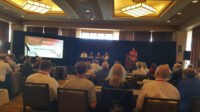At the recent Securing New Ground conference, held virtually October 28, Kastle CEO Haniel Lyn and Northland Controls CEO and Chair of SIA Board of Directors Pierre Trapanese spoke about trends they are seeing in returning to work.
“We are a cloud-based access control provider and we are able to see how occupancy has varied and changed over time,” Lyn said. “What we were looking for back in March when we thought people would be back [to work] in June, was, ‘What are we going to do to help clients feel safe and confident to return to work?’ We found that a lot of technologies, if you take them 10 degrees off of their security functionality, can help people feel safer, health-wise. Things like touchless access and health declarations are examples of how we took fundamental technology that we all manage and deal with and put a layer on top to help people return to work safely.”
Obviously, Lyn and his company were over-optimistic in the timeline (as were many others), but the concept is just as relevant today as many companies are still not fully back to work.
“These issues are not going away any time soon,” he said.
This was echoed by others at the conference as well. In an interactive poll session led by Brivo president and CEO Steve Van Till, attendees were asked to rank various trends as part of the Security Industry Association’s upcoming 2022 Megatrends report that will be released in December.
Almost three-quarters of the respondents said the trend to working remotely will create a long-term impact on the amount of security spending people do in their offices.
Some examples of the technologies and solutions expected to have the most impact going forward included artificial intelligence, predictive data analytics and smart — and healthy — buildings.
“I think there are a couple of things afoot now that have put this more in the limelight than in the past,” Lyn said. Customers are looking for ways to reduce costs and are starting to see what is possible with technology, he added. “Over the last two years, or at least during the pandemic, our clients have also recognized there is a flight to quality. These investments in improvements are mattering, whether it is a touchless system or [other security technology].”
Henry Hoyne, chief technology officer at Northland Controls, said his company has seen an increase in customers using analytics and leveraging existing cameras to collect information. “As we started to see offices open full-time or on a hybrid basis, we were seeing greater involvement from real estate wanting to know how spaces were being used, how long people were congregating, and whether they were socially distancing. There were a wide range of analytics we had to look for. … We also had to look for ways to eliminate as many touchpoints as possible.”
Trapanese said there is an ongoing trend for customers to raise the bar on a healthier environment in the workspace. “This is not just a fad; It will probably continue,” he added.
But there are also challenges ahead — especially supply chain issues and cybersecurity.
When asked how often the cybersecurity of physical security solutions/services come up in discussions with their customers today, respondents to the poll, over 60 percent said often and over one quarter responded always. Sixty percent said their company was placing “a lot more focus” on its supply chain today versus two years ago, pre-pandemic; and 47 percent listed supply chain delays has having the most significant impact on their business growth in the coming year.
Both of these things are potential hurdles to future projects and are something security integrators — and their customers — are likely to face for the coming year and beyond.








